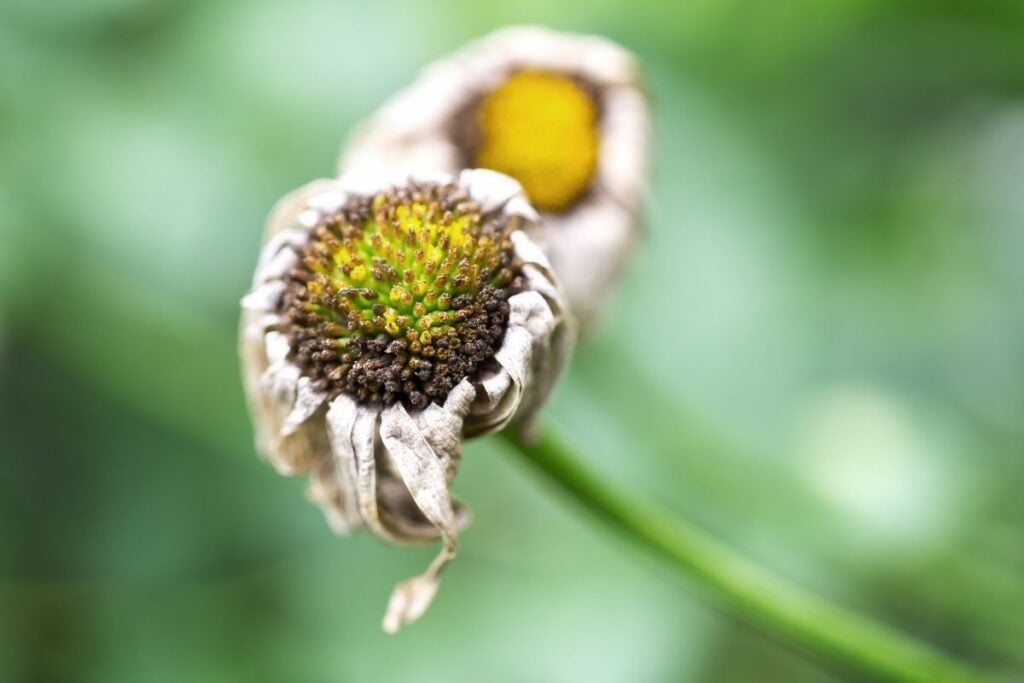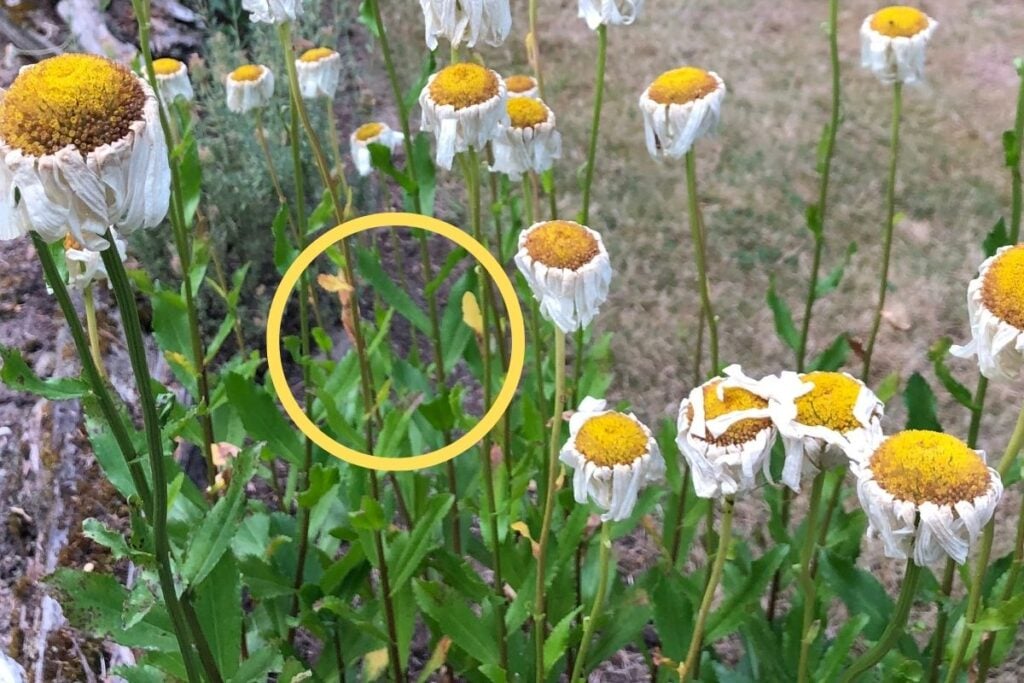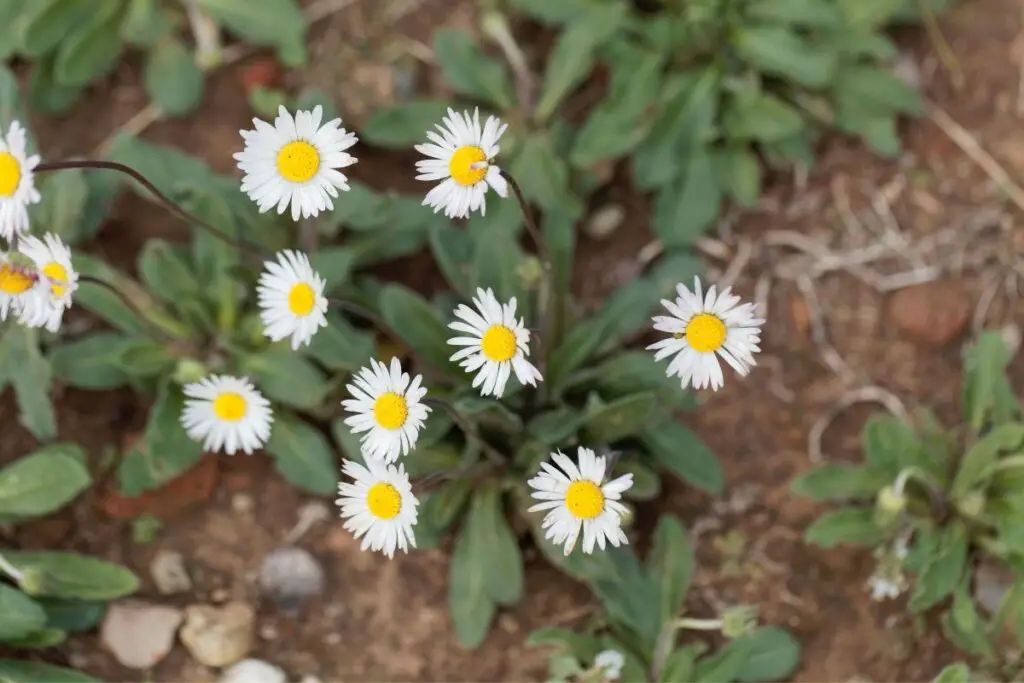If you are worried about your daisies dying, then you are at the right place. I planted daisies for the first time, and over a while, its leaves started wilting. I was apprehensive and was thinking if my daisies are going to die.
After spending quite a few years grooming the daisies, I learned quite a few things about them. Today I’ll tell you what could be the possible reason behind your dying daisies and how you can save them.
Poor lighting, inadequate watering, and pests are primary causes of a dying daisy plant. Signs of the dying plant include yellow leaves, drooping, and loss of leaves and flowers. Examine the signs, identify the problem, and then take the necessary steps to save the dying daisy plant.
We will discuss all the problems that can kill your daisies and also the steps to save them.

Why is my daisy plant wilting?
The most common reason for your daisy plant to be wilting is either overwatering or underwatering. The plant can wilt due to underwatering and become weak, but it can develop more severe issues if it is wilting due to overwatering.
Therefore, instead of overwatering, it is good that you underwater your plant so that there is always a chance for you to revive it quickly.
If your daisies are under the sun in scorching and dry weather, there are chances that the leaves will wilt due to a lack of moisture. The leaves tend to use the water stored in them as there is insufficient supply from the roots.
If your plant is deprived of water for too long, the leaves lose all their moisture. It leads to flat dry looking leaves, and they will end up wilting.
Wilting of leaves can happen while you are on vacation, and there is no one to water your plants, and neither is it raining. Since your daisies are under the sun for many days without any supply of water, they tend to suffer. It causes dehydration to them, and the leaves start to become dry and wilt.
On the other hand, overwatering can also be a reason why your daisies leaves are wilting. Since your plant sits on the water for a prolonged period, the flow of air and water is blocked, and the other parts of the plant cannot receive the nutrients.
It weakens the leaves and stems, and the plant starts to lose all its energy to hold its leaves and other parts in place.
When the plants receive water in surplus and the sunlight is not enough to evaporate the excess water, the leaves and roots suffer.
You will need to check the drainage of the soil and also stop the frequent supply of water. In case of poor drainage, you can add more sand to the soil and leave your plant under the sun for some days to recover.
Also read: How Much Water Do Daisies Need? (Daisy Water Requirements)
Looking for gardening supplies? We have tested 100's of products before recommending them to you guys. Check out our best pick below:
| Image | Gardening Supplies | Best Price? |
|---|---|---|
 Top
Top Top
Top | Raised Garden Bed Kit | Check On Amazon |
 | XLUX Soil Moisture Meter, Plant Water Monitor, Soil Hygrometer Sensor for Gardening, Farming, Indoor and Outdoor Plants, No Batteries Required | No Results |
 Top
Top Top
Top | 82 Pcs Garden Tools Set and Extra Succulent Tools Set | Check On Amazon |
 | Joeys Garden Expandable Garden Hose with 8 Function Hose Nozzle, Lightweight Anti-Kink Flexible Garden Hoses, Extra Strength Fabric with Double Latex Core, (50 FT, Black) | No Results |
 Top
Top Top
Top | Dual Chamber Compost Tumbler | Check On Amazon |
 Top
Top Top
Top | Sunnyglade Plant Stakes | Check On Amazon |
 Top
Top Top
Top | Organic Cold Pressed Neem Seed Oil | Check On Amazon |
 Top
Top Top
Top | Mighty Mint Gallon :-Insect and Pest Control Peppermint Oil | Check On Amazon |
 Top
Top Top
Top | Scotts DiseaseEx Lawn Fungicide | Check On Amazon |
 Top
Top Top
Top | Jacks Classic 20-20-20 All Purpose Fertilizer | Check On Amazon |
 Top
Top Top
Top | 30,000 Seeds Pollinator Attracting Wildflower Mixture | Check On Amazon |
 Top
Top Top
Top | Survival Vegetable Seeds Garden Kit-Over 16,000 Seeds | Check On Amazon |
Change in the color of leaves

The color of the leaves of your daisies can change due to various reasons. The color can change to yellow, black, and brown due to inadequate lighting, unfavorable temperatures, and improper watering.
If your daisies do not receive enough sunlight, it will hinder photosynthesis and will discolor the leaves.
Daisies are sun-loving plants, and if they are grown in poor lighting conditions, they might show signs of leaves being discolored or turning yellow or brown.
But if the sun is too harsh on your daisies on hot summer days, then the plant might suffer sunburn, and the color of leaves can change in such conditions. If the plant bears flowers, its color can fade away and become dull under the harsh sun.
Inadequate watering can also be a reason for the change in color of the leaves. Suppose the soil is dry and flaky for too long; it will deprive the plant of moisture, and ultimately, after using up all the water from the leaves, it will become dry. The color of leaves might change to yellow or brown.
Too much watering can be more dangerous for your daisies because the damage cannot be reversed most of the time unless it is identified early.
The daisies don’t like a scorching and humid climate. If the temperature rises suddenly above 85°F, the plant might suffer sunburn, and the leaves can turn yellow or brown.
Also read:
- How Much Light Do Daisies Need? (Daisy Light Requirements)
- Why Is My Daisy Turning Yellow? (Possible Problems+Solution)
- Why Are My Daisy Leaves Turning Brown? (Causes+How To Fix)
Holes or spots on the leaves
Holes and spots on the leaves of your daisy plant indicate that pests have infested the plant. You might be unable to see the pests from your naked eyes as they are very tiny, but if you look closely, you will understand the reason behind the holes and spots on the daisy leaves.
As the pests are almost invisible in the initial stages, you might not spot them at all, but in the later stages, you will notice the pest infestation when the spots become visible.
Daisies are tough and sturdy, and they are unlikely to be attacked by pests. But if they stay in unfavorable conditions for a more extended period, they might attract pests and bugs.
As the pests feed on the leaves, they can make small holes and attract mold to grow on the leaves. It can result in black leaves.
The plant loses its nutrients due to the infestation of pests. The leaves develop spots and holes because of the pests and are not able to perform photosynthesis. It causes the discoloration of the leaves.
Overwatering can also be a reason for holes and spots on the leaves because due to overwatering, the plant can suffer root rot, due to which it becomes weak and cannot grow normally. Since it is fragile and moist, it becomes a breeding ground for the pests and hence the change in color of the leaves.
You need proper investigation for a reason due to which the leaves of your daisies are developing holes and spots and treat them accordingly. The holes and spots are signs through which your plant wants to tell you that something is wrong.
Also read: How To Get Rid Of Bugs On Daisies? (Common Bugs+Solution)
How do you revive your daisy plant?

The foremost thing is to identify the problem and then try to fix it. Your daisies might suffer from any of the issues discussed above, so beware and act accordingly.
If the cause of your daisies sickness is lack of nutrition, you will need to provide it with proper nutrients in the form of fertilizers throughout the growing season but don’t overdo it as it can stress your plant.
If your plant is already overfed, avoid using any fertilizer and provide it with proper sunlight and moisture to make it look healthy again. Don’t fertilize unless the plant has used up all the nutrients from the soil.
If your daisies are underwatered, provide them with an adequate amount of water and make sure that the soil is made up of a sand base not to hold up a lot of moisture. Daisies don’t like too much water being retained by the soil; therefore drip irrigation process can be helpful for them. Watering them once a week will suffice.
If the plant is overwatered, leave them under the sun, let them dry, and if the sunlight is not reaching them, you will need to replant them or transplant them at a different spot to save them.
To check whether the soil is damp, you can dig your finger inside the soil and see if the soil beneath is dry or moist. If you notice that the soil is sticking to your finger, it means it is still wet from inside.
Therefore, wait for a few more days before watering the plant. This is how you can manage the moisture levels of your plant, and you will be able to avoid both over and underwatering.
Occasionally pruning your daisies is an excellent idea to help them grow better, so remember to trim off the part of the plant which is already damaged or dried out.
Also read: Do Daisies Need Fertilizer?
What to do if your daisies are dying?
If your daisies show signs that they are not healthy, there is still enough time to revive and rejuvenate them. You can help them recover by fixing the issue.
For example, if your daisy is suffering due to a lack of water, you can start watering it slowly, and you will see it getting better as it gradually absorbs moisture from the soil.
In some rare cases, a situation might arise where the revival of your plant is not possible. In such scenarios, you need to take a call to remove the damaged part and replant your daisies.
You can also divide your daisies in case some of them have completely died. You need to dig the mulch out of the ground and divide the affected part from the active part. Replant the part which is in the scope of revival at a different spot.
Do daisies need any medication?
Daisies are sturdy plants and usually don’t need medication until bugs and pests infest them. They can recover and thrive if favorable conditions are provided.
If you can fix the problem, that should help them recover completely.
The daisies can also survive in some extreme conditions and thrive in challenging and unfavorable conditions.
To save your daisies from problems, you need to avoid the below-mentioned issues:
- Do not overwater your daisies.
- Provide them with adequate moisture.
- Let them stay under bright sunshine throughout the day.
- Use very well-draining soil.
- Keep them in an open space in your garden.
Also read: Are My Daisies Dying? (7 Signs Of A Dying Daisy Plant)
Ref: Wikipedia, Britannica, University Of Florida, Ucanr.edu
